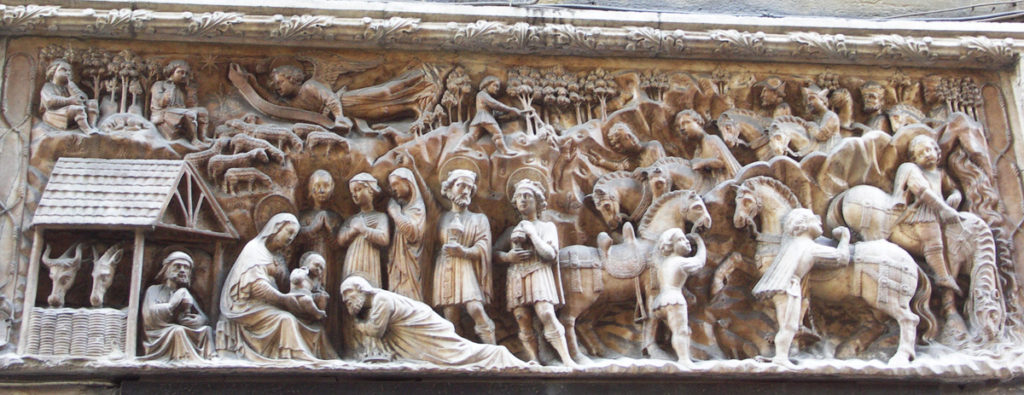An Englishman in Genova
18 Lug 2017 - Cultura, La città, Magazine
Per qualche tempo an Englishman in Genova, Chris Thomson, esperto e docente di organisational culture, ha mantenuto un forte attaccamento per questa città. In un precedente post ci ha condotto con un suo breve poem alle origini della storia cittadina. Ci regala ora un altro suo omaggio a Genova.
Una passeggiata nei caruggi del centro storico, respirando magiche atmosfere in compagnia di draghi e pifferai. Seguendo l’eco dei versi del poeta genovese Edoardo Firpo, sulle tracce dello scultore Giovanni Gaggini.
La sua testimonianza ve la lasciamo nella versione originale.
Go and get lost in the old city!
Genova, and particularly its wonderful old quarter, the centro storico, is a different place from the one I first got to know almost forty years ago.
Back in 1980 the Carlo Felice theatre was in ruins. ‘Red brigades?’ I enquired nervously of my employer as we drove by. ‘No,’ he replied ‘British navy’. Presumably during the same bombardment that put a shell through the cathedral roof and which fortunately failed to explode.
In those days via Balbi was choked with bus fumes and you could still find signs on the walls saying ‘Off limits to allied troops’.
Much of the centro storico seemed to be equally off-limits to much of the local population. Dark rumours circulated about the fate that might befall you if you wandered down there at night – or went shopping there at any time of day.
But I fell in love with it. The implacable facades and noisy avenues of the modern city seemed unfriendly and cold by comparison. But the narrow lanes – the caruggi – with their intriguing twists, turns, angles and corners opening out suddenly into tiny, medieval squares – this was totally different and like nowhere else I’d ever been.
I loved the way its unique architectural character was matched by its specific, local language: not Italian, but dialect of the place: Zeneise. And the two came together in the poems of Eduardo Firpo, for example the one inspired by Piazza San Matteo – Ciassa san Matté:
Quande do Quattroçento
lasciòu in porto a barca
in Ciassa San Mattë
co i êuggi maveggiæ
se gh’è fermoòu Petrarca
passava o doçe vento
da primmaveja in fiore,
e Zenaa l’ea d’Italia
a ciù bella çittæ.
Edoardo Firpo, “Ciassa San Mattë” (*)
Since 1992 when the city celebrated the 500th anniversary of Columbus’ great voyage of discovery, the centro storico has been greatly cleaned and made more inviting but to this day, if you just raise your gaze a little as you wander and explore you can still breathe the spirit of the medieval and early Renaissance.
Above all, there are the carved reliefs of St George and the dragon over the entrances to many of the old palazzi. Many of these are the work of Giovanni Gaggini, who was born and died in Switzerland but who spent much of his life working as a sculptor in Genova during the latter half of the fifteenth century.
Examples of his work have made their way as far afield as museums in London and Kansas City but if you’re in Genova there’s no better place to begin searching him out than in Via degli Orefici and Piazza san Matteo.
The reliefs in both these locations show that wonderful early Renaissance interest in the ordinariness and actuality of the world we live and breathe in. In the Via degli Orefici nativity scene, look at the way one of the horsemen stiffens his leg in order to stay in the saddle while his horse bends to drink – or the weight you can feel exerted on the stirrup by his comrade who steadies himself to mount.
My favourite figure of all is that of the shepherd-piper. You can find him in both reliefs playing to his grazing sheep. I think of him almost as Gaggini’s signature, a way not just of saying ‘I made this’ but also an artistic credo, his Renaissance interest in the world around him evident in the care he’s taken even to show the piper’s puffed cheeks as he squeezes out what we can only imagine would be a rough and reedy, rustic music.
Gaggini’s work – on display in Genova for over five hundred years for anyone who cares simply to stop and look – has that truth which W. H. Auden identified in his poem ‘Musee des Beaux-Arts’: how, while ‘something amazing’ is happening – a dragon being killed or the Messiah being born –
(…) there always must be
Children who did not specially want it to happen, skating
On a pond at the edge of the wood:
They never forgot
That even the dreadful martyrdom must run its course
Anyhow in a corner, some untidy spot
Where the dogs go on with their doggy life and the torturer’s horse
Scratches its innocent behind on a tree.
So with Genova’s centro storico looking better now than it has for many a long year, no excuses: go and get lost in it – and find another masterpiece by Gaggini for yourself!
(*) L’Inglese no, ma questa ve la dobbiamo tradurre!
Piazza San Matteo
Quando nel Quattrocento/lasciata in porto la barca/in Piazza San Matteo/ con occhi pieni di meraviglia/ si è fermato il Petrarca/ spirava il dolce vento/ della primavera in fiore/e Genova era d’Italia/ la più bella città. (E.Firpo, in Tutta Zena ciù un carroggio).

